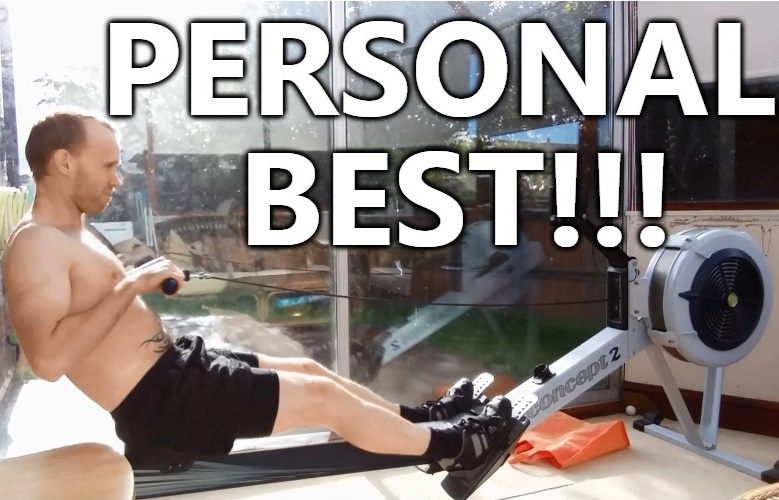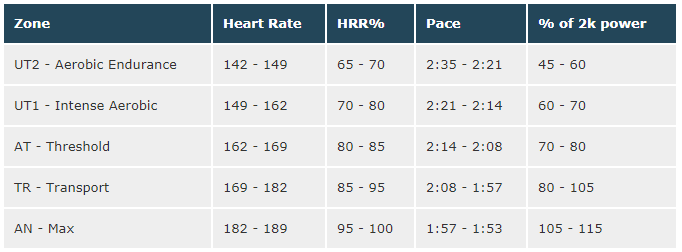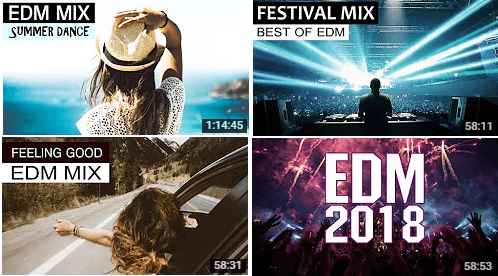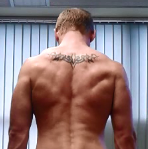
Selecting a Program
I started by researching online for training programs designed to improve my 2000m rowing time. The first articles I found pointed me towards either The Wolverine Plan or The Pete Plan. Both seemed like quite intense training programs and I was hoping for a less time-consuming alternative. After creating this spreadsheet to collate a few other programs, I settled on a Custom Plan from a recommended website.
My main reasons were:
- Simplicity – Once you know the training zone for each workout you simply row it at that pace.
- Volume – I selected four sessions per week which seemed more manageable than the 6 sessions in the popular Pete Plan.
- Taper – The intention was to peak on a specific day. The built-in taper meant it eased down the intensity in the final week so that I was fresh for race day.

The Training
I selected an 8 week block of training. The four days chosen by me were Monday, Wednesday, Thursday and Sunday.
I pulled some gym exercises from this article and made a little gym routine. I followed this routine on Wednesdays, Fridays and Sundays. This included things like Power Cleans, Front Squats, RDL, Push ups, Batwing Rows, Pull ups and Inverted Rows. These are exercises aimed at making me more resilient to injury and stronger in the muscles used for the rowing stroke.
Each workout you’re presented with a range which your pace should be between. This is determined by your time in the initial 2000m time trial on day one. My 2km time trial was 7:55.2 and that meant e.g. the Wednesday session of 10 x 1 minute row, 1 minute rest was to be completed between a pace of 1:53 and 1:57 per 500m (prominent on the rowing machine display).

Training Considerations
What surprised me most was the lack of intensity in each session. It was my choice to not aim for the lowest possible split in each workout, but I still kept to the faster end of the range. A good friend of mine is an endurance athlete and I’m aware a lot of the training is at a low intensity. This is something I’m not used to coming from a sprinting background, and so I trusted the process. For the longer sessions my focus was on stroke rate. Where a range of 22-26 SPM was recommended I would complete each piece (rowing lingo for rep) at a consistent and varied pace. If I had 3 x 13 minutes the reps would be completed at 22, 24 and 26 SPM respectively.
It wasn’t long before I started using music to distract me from the monotony. I even experimented with selecting music whose tempo matched my stroke rate. 22 SPM would fit 88 BPM music, but I found as soon as I was off the beat it was more of a hindrance to get back on it, so I returned to music for entertainments sake. I recommend something upbeat, such as EDM (Electronic Dance Music) of which there are hundreds of hour long mixes available on YouTube.

In terms of technique I already knew some of the basics and I didn’t do much tweaking. I did try to pull the handle slightly higher up my chest and avoid bending my arms too soon into the stroke. What struck me was just how much the biceps are used in a rowing stroke. They were the first thing to fatigue and often had soreness the following day. This could be a flaw in my technique but the soreness continued with me throughout the 8 weeks and I think I managed to build some muscle from it.
Tapering
The taper began in the middle of week 7, with 10 days to go. This was a welcome relief and I used the opportunity to ease off and eventually stop all gym training. One thing I did was to replace that with flexibility and mobility work. Despite strict post-workout stretching I found myself getting tightness in my legs and back. I’m confident this shaved a few seconds off my final time by allowing my muscles to operate fluidly during each stroke.

The program it generated for me, based on 4 sessions/week for 8 weeks. Each session has a Training Zone referenced from the table earlier.
The Time Trial
I started off with a thorough 15-20 minute warm-up. Most of this took place away from the rower doing active stretches such as leg swings and squats. In terms of strategy all I knew was to pull four hard strokes and immediately settle into my rhythm. I could have a desired pace in mind but it’s important to feel natural in the rhythm you hold. Luckily for me that was slightly faster than I anticipated.
In my head I broke it down into 4 x 500m. In the first three I hold a given pace and in the fourth I deliberately increase my stroke rate. This is to compensate for what would be a reduced power output per stroke due to fatigue. It didn’t go exactly to plan as I was falling off the pace with 1k to go. The final 500m was more about holding on than any sort of “sprint finish”. I was very chuffed to stop the clock at 7:29.2. This was a full 26 seconds faster than I’d managed on my first day. On day 1 I think I could have pushed more whereas after this I knew I gave my all. I paid for it with a full 10 minutes writhing around on the floor breathing like a faulty vacuum cleaner.
Think of the 2k as 4 x 500m. Maintain for the first three and then increase stroke rate for the final 500m.
Conclusion
If you are looking to peak for a certain rowing event then I’d recommend the Custom Plan to anyone. One word of caution is that if you do feel you are improving very quickly, either through fitness or technique, then the initial pacing might soon become too slow for an optimal training effect. Don’t be afraid to go a second or two faster. Alternatively, estimate a new 2000m time and work off those numbers instead.
For a program to suit your general training The Pete Plan is a really popular choice. There are two sessions each week that change in a three week cycle. Once you’re onto week 4 you have identical sessions to compare and see if your fitness is improving. If this all seems like too much work then the British Rowing Intermediate plan is included in this spreadsheet (same as earlier). That is two short rowing workouts per week alongside 10-15 minutes of additional cardio (running, cycling etc.).
If your rowing technique needs a lot of work I’d keep the additional cardio the rowing machine and use it as an opportunity to refine your stroke. Finally the original Wolverine Plan, taken from a Women’s University Rowing Team, involves some longer workouts. This would suit someone less constrained by time who perhaps prefers to do more at a slower pace.

